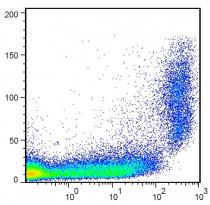ARG62946
anti-CD9 antibody [EM-04] (FITC)
anti-CD9 antibody [EM-04] (FITC) for Flow cytometry and Mouse
Cell Biology and Cellular Response antibody; Developmental Biology antibody; Immune System antibody
Overview
| Product Description | FITC-conjugated Rat Monoclonal antibody [EM-04] recognizes CD9 |
|---|---|
| Tested Reactivity | Ms |
| Tested Application | FACS |
| Specificity | The clone EM-04 recognizes CD9 antigen, a 24 kDa transmembrane protein expressed on platelets, monocytes, pre-B lymphocytes, granulocytes and activated T lymphocytes. |
| Host | Rat |
| Clonality | Monoclonal |
| Clone | EM-04 |
| Isotype | IgG1 |
| Target Name | CD9 |
| Antigen Species | Mouse |
| Immunogen | Permeabilized murine bone marrow-derived mast cells (BMMC). |
| Conjugation | FITC |
| Alternate Names | Leukocyte antigen MIC3; BTCC-1; TSPAN-29; MIC3; Tetraspanin-29; p24; Cell growth-inhibiting gene 2 protein; CD9 antigen; MRP-1; DRAP-27; 5H9 antigen; CD antigen CD9; TSPAN29; Motility-related protein; Tspan-29 |
Application Instructions
| Application Suggestion |
|
||||
|---|---|---|---|---|---|
| Application Note | * The dilutions indicate recommended starting dilutions and the optimal dilutions or concentrations should be determined by the scientist. |
Properties
| Form | Liquid |
|---|---|
| Purification Note | The purified antibody is conjugated with Fluorescein isothiocyanate (FITC) under optimum conditions. The reagent is free of unconjugated FITC. |
| Buffer | PBS (pH 7.4) and 15 mM Sodium azide |
| Preservative | 15 mM Sodium azide |
| Concentration | 0.5 mg/ml |
| Storage Instruction | Aliquot and store in the dark at 2-8°C. Keep protected from prolonged exposure to light. Avoid repeated freeze/thaw cycles. Suggest spin the vial prior to opening. The antibody solution should be gently mixed before use. |
| Note | For laboratory research only, not for drug, diagnostic or other use. |
Bioinformation
| Database Links | |
|---|---|
| Gene Symbol | Cd9 |
| Gene Full Name | CD9 antigen |
| Background | CD9 belongs to proteins of tetraspanin family that orchestrate cholesterol-associated tetraspanin-enriched signaling microdomains within the plasma membrane, forming complexes with each other as well as with integrins, membrane-anchored growth factors and other proteins. CD9 is involved in cell motility, osteoclastogenesis, neurite outgrowth, myotube formation, and sperm-egg fusion, plays roles in cell attachment and proliferation and is necessary for association of heterologous MHC II molecules on the dendritic cell plasma membrane which is important for effective T cell stimulation. CD9 is also considered as metastasis suppressor in solid tumors. |
| Function | Involved in platelet activation and aggregation. Regulates paranodal junction formation. Involved in cell adhesion, cell motility and tumor metastasis. Required for sperm-egg fusion (By similarity). Acts as a receptor for PSG17. [UniProt] |
| Research Area | Cell Biology and Cellular Response antibody; Developmental Biology antibody; Immune System antibody |
| Calculated MW | 25 kDa |
| PTM | Palmitoylated at a low, basal level in unstimulated platelets. The level of palmitoylation increases when platelets are activated by thrombin (in vitro). The protein exists in three forms with molecular masses between 22 and 27 kDa, and is known to carry covalently linked fatty acids. |
Images (1) Click the Picture to Zoom In






